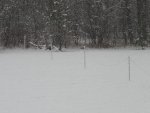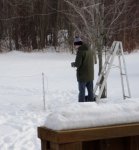With the waterfall, it's easy to spot low-strength broadcasts. I'd say, out of 40 visible radio stations across the tropical bands, perhaps 8 or 10 are strong enough to have good audio. The remaining stations are visible on the waterfall, but the background noise is too high to get good audio. I'm using WinRadio software, which has a noise reduction button, and it works.....to a point. I'd like to get your advice on upgrading to the next level.
No matter what you do, no matter how good the radio, how large the antenna farm, how well planned or engineered the system, you are always going to have signals that are visible, but not usable. It is the nature of the beast.
So....how to get more selectivity, more sensitivity? How to drop the background noise?
The SoftRock has a fairly low quality front end. The sensitivity and MDS are not great. As such a low noise amplifier could be a real help to you.
In general too many people lean on amps to do something for them, when the rest of the system is already up to performing at the natural noise floor. So I hesitate to suggest LNAs for most HF installations as an early step. Get everything else right first, and then go the LNA route. In this case it might be a good idea though.
However, keep in mind that your SoftRock, like all sound card based SDRs, has a higher noise floor than would be found in a good tabletop or a DDC SDR. While the sound card based SDR can be designed with exactly the same front end as a DDC SDR you can never get rid of the issue of the sound card induced noise floor.
Selectivity. One of the very strong points of SDR is the selectivity they bring to the table. When you get right down to it no other radio type currently in use is better. And the best “radios” that are not SDR apply exactly the same design in a DSP without requiring a computer to run it, just a dedicated hardware interface instead.
The software filters have very sharp cutoff, better than can be found in any hardware filter (example, crystal filters). The software filters are fully adjustable, to meet the needs of the moment.
A DDC SDR will have slightly better selectivity than a sound card based SDR, again because of the sound card, but really this will be undetectable to your ear or in your use. The improvement is there and measurable, no doubt, but just not a factor in use. The DDC SDR will have better image rejection, and that can be seen in use.
Background noise…again just a fact you have to live with. As KB2VXA has suggested a properly done ground might improve this, and will be better from a lightning standpoint. I have also had some luck with common mode chokes. But, background noise is always going to be there…and at much higher levels than a person coming from a scanner background is used to dealing with.
The next step up in SDRs is the SDR IQ for about $525. Beyond that, all other SDRs are $1000 or more. I'm not sure if any of them have the right muscle.....or for that matter how to call out the right muscle....and compare it with table top systems. And I'd rather not blow more money till I learn.
If you moved up to the SDR-IQ from your SoftRock you could see a slight improvement in sensitivity. It might, or might not, be enough to see, depending on the natural noise floor at your location and with your installation.
Image rejection would show a significant improvement, probably more than 20 dB depending on what sound card you are now using with the SoftRock. Dynamic range would also improve, probably more than 25 dB better, again depending on what sound card you are currently using with the SoftRock. The DDC SDRs, like the SDR-IQ, are not limited by the sound card in these aspects.
All of the other DDC SDRs out there should show at least that much improvement in the same areas, several of them significantly more.
The WinRadio G31DDC can be had for around $850, although most places list it for $899. Pretty much all of the other DDC SDRs are $1000 or more.
Do DDC SDRs compare to tabletops? Absolutely. The question becomes, can tabletops compare to a well designed SDR? And then the answer in most ways is no, not for the same price point. The low cost SDR-IQ, as a package, is as good as tabletops costing quite a bit more, in many ways. There are several single factors that come up a little short, such as the front end and resistance to imaging above 15 MHz, but the overall package is very good.
A very well done analog receiver can have better dynamic range, but most don’t when compared to the better SDRs out there. In almost every other way a DDC SDR can, and some do, exceed the best tabletop analog receivers.
Right now the Perseus SDR is one of the best receivers you can buy, for any price. Its one real shortfall is in sensitivity, not bad at all mind you and well below the natural noise floor for most users so this is not a factor, but not quite as good as a few other more traditional receivers it competes with. In every other measurable way it is simply World class, in a few ways the World leader.
However, I’ll tell you, I like to use the WinRadio Excalibur more than I like to use the Perseus. Sure, the Perseus has better numbers, but I just like the way the Excalibur operates. I can’t quite put my finger on why but I think the Excalibur just seems to makes more low level signals more intelligible. The full width 30 or 50 MHz waterfall display at the bottom that keeps running no matter what you are looking closely at I the other windows is a fantastic feature. And the software for the Excalibur is, in my opinion, some of the best done for SDR currently available. Of course, it better be, none of the third party software out there supports the Excalibur yet and from past WinRadio history might never.
If you are thinking about upgrading to another, new, receiver, for short wave frequencies, then you really can’t go wrong with either the WinRadio Excalibur or the Microtelecom Perseus. When you compare them for performance in their covered ranges to any tabletop you can buy new today they are better and/or less costly.
Make a list of tabletop receivers, look at the prices. Only a couple of them cost less than an SDR, and those, while not bad radios, just cannot really compete in most ways or features.
Yep, if you are going to stay with the hobby, if you have decided it is something you want to pursue, and if you can afford the equipment without hardship, don’t be afraid of SDRs. They are new’ish, but they are likely the future of radio.
Oh, and get that antenna a little higher, you’ll like it even more

T!



